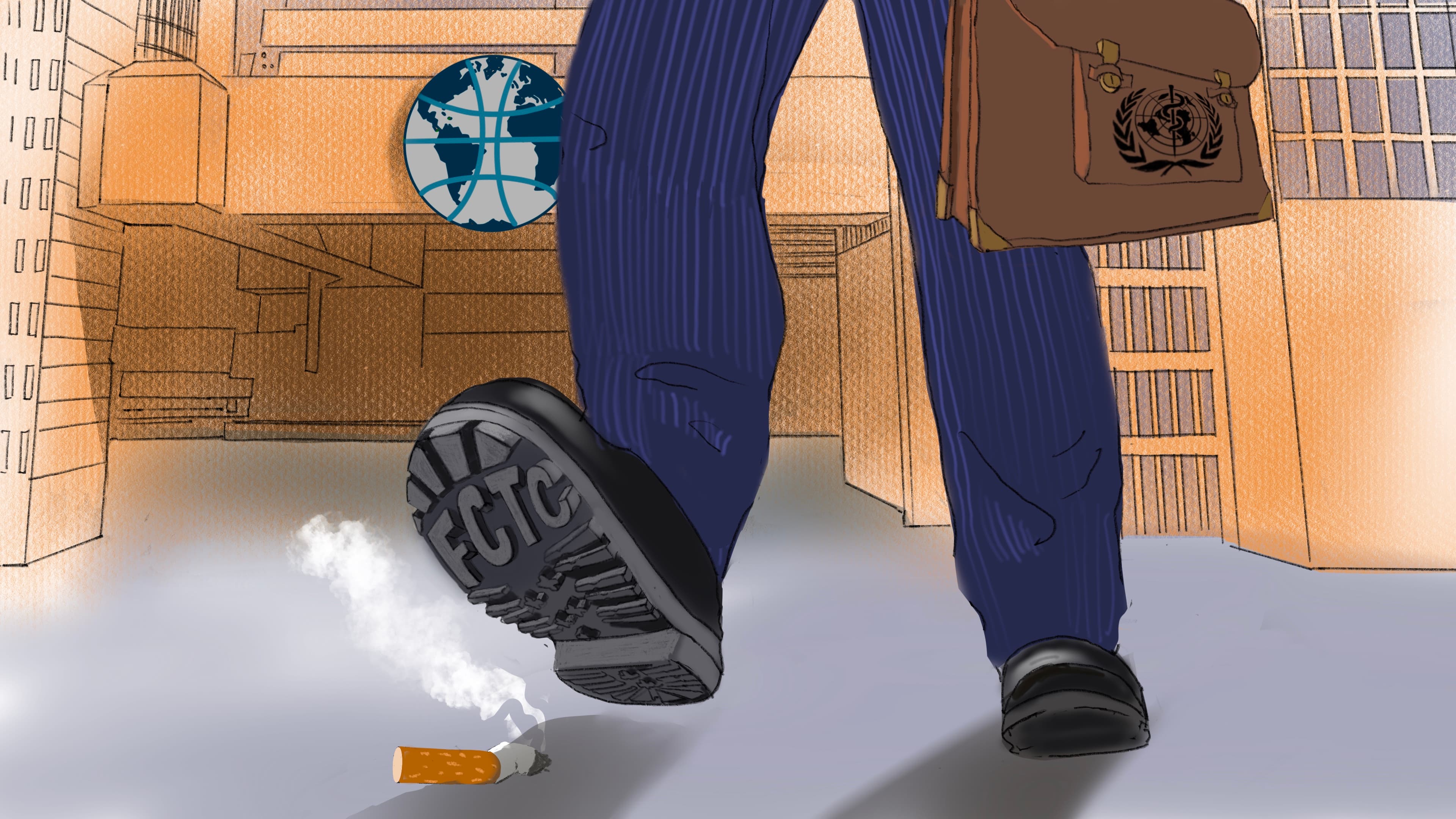It’s almost impossible to discuss tobacco policy without mentioning the World Health Organization Framework Convention on Tobacco Control. The landmark treaty, adopted 20 years ago, is one of the most widely embraced treaties in United Nations history, and has remained the leading regulatory framework for tobacco control globally. It undeniably has pushed adopters to embrace policies that have lowered smoking rates and other tobacco use — but it also has been undermined by the tobacco industry, limiting its effectiveness in some countries. The treaty is complex to both experts and newcomers alike, so The Examination has put together a guide with some answers to frequently asked questions.
What exactly is the WHO Framework Convention on Tobacco Control?
The trailblazing nature of the Framework Convention on Tobacco Control cannot be underestimated. It has been lauded as the world’s first public health treaty, and it’s the first international treaty negotiated by the World Health Organization. In essence, it’s an agreement that aims to improve people's health by legally committing countries that sign it to rules designed to reduce tobacco use. The concept of a multilateral treaty to fight the tobacco epidemic gained traction in the 1990s, when there were 3.5 million people dying each year from tobacco use, and the rate of deaths was estimated to reach 10 million by 2030 if something wasn’t done. The goal of the treaty is to provide countries with a regulatory strategy to prevent the harms of smoking and wider tobacco use by laying down a framework of tobacco control measures.
What are the tobacco control measures included in the treaty?
The treaty includes measures to reduce both the demand and supply of tobacco, and to protect public health policies from tobacco industry interference. The core provisions to reduce demand can be found in articles 6-14 of the treaty. These include measures to ban tobacco marketing, reduce demand through taxation, protect people from exposure to smoke, and regulate the contents of tobacco products. Articles 15-17 focus on reducing the supply of tobacco products by clamping down on illicit trade and encouraging countries to adopt laws that prohibit the sale of tobacco products to minors. One of the most vital and well known measures in the treaty is article 5.3, which compels countries to protect public health policies from tobacco industry interference.
Has the treaty been successful in its goal to protect people’s health from tobacco?
There is no denying that the measures laid out in the treaty have succeeded in reducing tobacco use in many parts of the world. Countries have used the treaty to strengthen their own national policies and even defend themselves against legal action from tobacco companies.
It’s not all good news. More than 8 million people a year die from diseases caused by smoking and other tobacco use. Some of the biggest signatories, like China, have broadly failed to live up to their commitments under the treaty — and tobacco sales remain strong in many developing countries, where there is large population growth, and where tobacco industry interference is rife.
There was also notable resistance: Japan, the United States and Germany all received a ‘Dirty Ashtray award’ from an alliance of anti-tobacco groups for their efforts to undermine the treaty in an apparent effort to protect their domestic tobacco industries. The U.S., while initially enthusiastic about a treaty during the Clinton administration, changed course during the presidency of George W. Bush, and is one of just a handful of countries that participated in the talks but failed to ratify it.
How is the FCTC enforced?
There are no financial penalties or other kinds of sanctions for countries that fail to uphold the measures in the treaty. Instead it primarily relies on a system of good faith. Like most international treaties, there is an expectation that when a country signs on, they will enforce it. “Generally speaking, there's no obligation for [countries] to sign up to a treaty,” says Thomas F. McInerney, an international lawyer and executive director of the Rule of Law for Development Program at Loyola University Chicago School of Law. “When they sign up to the treaty they are showing, in some way, their willingness to be bound [to its obligations.]” The treaty states that parties will “strive in good faith to ratify, accept, or approve it, and show political commitment not to undermine the objectives set out in it.”
Why tobacco is a core beat at The Examination
However, there is sometimes little that can be done when a country is suspected of breaking the treaty. In one instance, a Dutch non-governmental organization attempted to sue its government for not adhering to an article in the treaty, but the court found the article did not have a direct effect on the Dutch government. Countries are required to submit periodic progress reports to the Conference of Parties, which governs the treaty. However, the submissions are self-reported and researchers have said they are not always accurate. Plans to improve the reporting system are currently underway, according to a spokesperson for the governing agency.
Which countries have signed the treaty?
There are 183 countries, representing 90% of the world’s population, that have become ‘parties’ to the treaty since it was adopted in 2003 and brought into force two years later. Confusingly, a handful of countries that were signatories to the original treaty have not officially become parties to the treaty, including the United States and Switzerland. This means they are not bound by the obligations set out in the treaty. Major tobacco-producing countries like China, Brazil, Zimbabwe and India are all parties to the treaty.
However, even when countries are parties to the treaty they do not always adhere to all the measures in the treaty China still has not introduced a national indoor smoking ban, despite this being one of the core elements of the treaty, Meanwhile, a few countries are neither a party nor a signatory with Indonesia being the most notable example due to its population size and its important role in tobacco production. Indonesia’s stance means it is not obliged to adhere to any measures set out in the treaty. The country has some of the most lax rules around tobacco advertising in the world today and the highest rates of smoking.
Why has there been resistance to the treaty?
There are a number of reasons behind countries shunning the treaty or measures within it. A 2021 report from Stopping Tobacco Organizations and Products, a global tobacco industry watchdog, found that tobacco industry interference in legislation and regulation is rife, and many governments are susceptible to demands and lobbying of Big Tobacco companies, which has resulted in compromised health policies.
Subscribe to our newsletter
Global health reporting, straight to your inbox
The battle to pass national laws to uphold the treaty is an ongoing fight. A current bill passing through the Peruvian congress that would bring its law in line with the treaty is being fiercely resisted by the tobacco industry, tobacco control groups say. The tobacco industry has also turned to litigation to fight the treaty. This has included British American Tobacco’s South African subsidiary attempting to overturn a ban on tobacco advertising by arguing it limited the industry’s freedom of speech.
How do I find out if my country is enforcing the treaty?
Countries are required to submit implementation reports at regular, two-year intervals, and submitted reports can be found online. Since 2008, the WHO has also released a report on the global tobacco epidemic, which tracks the progress made by countries in implementing tobacco control measures. While these documents can give you an idea of how well your country might be doing to enforce the treaty, one important step is to look at the policies implemented by your country and compare them to the treaty itself and the WHO’s guidelines. A country-by-country guide to tobacco laws can be found here, but it’s best to check if these are up-to-date by checking them against your own country’s current legislation.
Does the treaty apply to new tobacco industry products such as e-cigarettes?
The regulation of e-cigarettes (or vapes) is not specifically cited in the core recommendations of the treaty, but they are a fiercely disputed topic at the FCTC’s biennial ‘Conference of the Parties’ (COP), which convenes to debate and agree to updates to the treaty.
At the COP held in 2016, countries were invited to consider applying regulations to prohibit or restrict the use of vapes in a manner “appropriate to their national laws and public health objectives.” Some countries have introduced an outright ban on the sale of e-cigarettes, while others regulate e-cigarettes as tobacco products, which means they cannot be advertised or used in enclosed spaces. Other countries, such as the U.K., have a much more permissive attitude toward vapes and treat them as consumer products that encourage smokers to quit cigarettes.
It is expected e-cigarette regulation will be a contentious issue once again at the next COP this November and battle lines have already been drawn. Neil O’Brien, a junior minister at the U.K.’s Department of Health and Social Care, has already stated that the U.K. delegation “will not agree to any decisions which would impact on our ability to make vapes available for smokers who wish to quit.”


